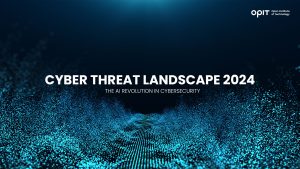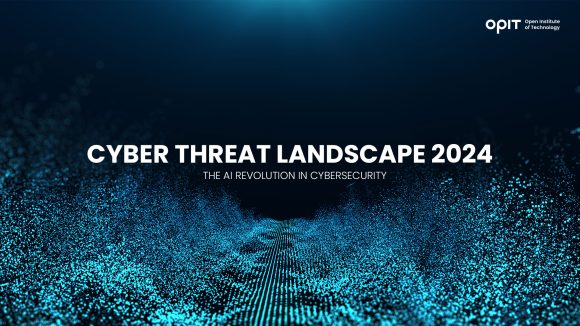

There’s no doubt about it – artificial intelligence has revolutionized almost every aspect of modern life. Healthcare, finance, and manufacturing are just some of the sectors that have been virtually turned upside down by this powerful new force. Cybersecurity also ranks high on this list.
But as much as AI can benefit cybersecurity, it also presents new challenges. Or – to be more direct –new threats.
To understand just how serious these threats are, we’ve enlisted the help of two prominent figures in the cybersecurity world – Tom Vazdar and Venicia Solomons. Tom is the chair of the Master’s Degree in Enterprise Cybersecurity program at the Open Institute of Technology (OPIT). Venicia, better known as the “Cyber Queen,” runs a widely successful cybersecurity community looking to empower women to succeed in the industry.
Together, they held a master class titled “Cyber Threat Landscape 2024: Navigating New Risks.” In this article, you get the chance to hear all about the double-edged sword that is AI in cybersecurity.
How Can Organizations Benefit From Using AI in Cybersecurity?
As with any new invention, AI has primarily been developed to benefit people. In the case of AI, this mainly refers to enhancing efficiency, accuracy, and automation in tasks that would be challenging or impossible for people to perform alone.
However, as AI technology evolves, its potential for both positive and negative impacts becomes more apparent.
But just because the ugly side of AI has started to rear its head more dramatically, it doesn’t mean we should abandon the technology altogether. The key, according to Venicia, is in finding a balance. And according to Tom, this balance lies in treating AI the same way you would cybersecurity in general.
Keep reading to learn what this means.
Top of Form
Implement a Governance Framework
In cybersecurity, there is a governance framework called ISO/IEC 27000, whose goal is to provide a systematic approach to managing sensitive company information, ensuring it remains secure. A similar framework has recently been created for AI— ISO/IEC 42001.
Now, the trouble lies in the fact that many organizations “don’t even have cybersecurity, not to speak artificial intelligence,” as Tom puts it. But the truth is that they need both if they want to have a chance at managing the risks and complexities associated with AI technology, thus only reaping its benefits.
Implement an Oversight Mechanism
Fearing the risks of AI in cybersecurity, many organizations chose to forbid the usage of this technology outright within their operations. But by doing so, they also miss out on the significant benefits AI can offer in enhancing cybersecurity defenses.
So, an all-out ban on AI isn’t a solution. A well-thought-out oversight mechanism is.
According to Tom, this control framework should dictate how and when an organization uses cybersecurity and AI and when these two fields are to come in contact. It should also answer the questions of how an organization governs AI and ensures transparency.
With both of these frameworks (governance and oversight), it’s not enough to simply implement new mechanisms. Employees should also be educated and regularly trained to uphold the principles outlined in these frameworks.
Control the AI (Not the Other Way Around!)
When it comes to relying on AI, one principle should be every organization’s guiding light. Control the AI; don’t let the AI control you.
Of course, this includes controlling how the company’s employees use AI when interacting with client data, business secrets, and other sensitive information.
Now, the thing is – people don’t like to be controlled.
But without control, things can go off the rails pretty quickly.
Tom gives just one example of this. In 2022, an improperly trained (and controlled) chatbot gave an Air Canada customer inaccurate information and a non-existing discount. As a result, the customer bought a full-price ticket. A lawsuit ensued, and in 2024, the court ruled in the customer’s favor, ordering Air Canada to pay compensation.
This case alone illustrates one thing perfectly – you must have your AI systems under control. Tom hypothesizes that the system was probably affordable and easy to implement, but it eventually cost Air Canada dearly in terms of financial and reputational damage.
How Can Organizations Protect Themselves Against AI-Driven Cyberthreats?
With well-thought-out measures in place, organizations can reap the full benefits of AI in cybersecurity without worrying about the threats. But this doesn’t make the threats disappear. Even worse, these threats are only going to get better at outsmarting the organization’s defenses.
So, what can the organizations do about these threats?
Here’s what Tom and Venicia suggest.
Fight Fire With Fire
So, AI is potentially attacking your organization’s security systems? If so, use AI to defend them. Implement your own AI-enhanced threat detection systems.
But beware – this isn’t a one-and-done solution. Tom emphasizes the importance of staying current with the latest cybersecurity threats. More importantly – make sure your systems are up to date with them.
Also, never rely on a single control system. According to our experts, “layered security measures” are the way to go.
Never Stop Learning (and Training)
When it comes to AI in cybersecurity, continuous learning and training are of utmost importance – learning for your employees and training for the AI models. It’s the only way to ensure all system aspects function properly and your employees know how to use each and every one of them.
This approach should also alleviate one of the biggest concerns regarding an increasing AI implementation. Namely, employees fear that they will lose their jobs due to AI. But the truth is, the AI systems need them just as much as they need those systems.
As Tom puts it, “You need to train the AI system so it can protect you.”
That’s why studying to be a cybersecurity professional is a smart career move.
However, you’ll want to find a program that understands the importance of AI in cybersecurity and equips you to handle it properly. Get a master’s degree in Enterprise Security from OPIT, and that’s exactly what you’ll get.
Join the Bigger Fight
When it comes to cybersecurity, transparency is key. If organizations fail to report cybersecurity incidents promptly and accurately, they not only jeopardize their own security but also that of other organizations and individuals. Transparency builds trust and allows for collaboration in addressing cybersecurity threats collectively.
So, our experts urge you to engage in information sharing and collaborative efforts with other organizations, industry groups, and governmental bodies to stay ahead of threats.
How Has AI Impacted Data Protection and Privacy?
Among the challenges presented by AI, one stands out the most – the potential impact on data privacy and protection. Why? Because there’s a growing fear that personal data might be used to train large AI models.
That’s why European policymakers sprang into action and introduced the Artificial Intelligence Act in March 2024.
This regulation, implemented by the European Parliament, aims to protect fundamental rights, democracy, the rule of law, and environmental sustainability from high-risk AI. The act is akin to the well-known General Data Protection Regulation (GDPR) passed in 2016 but exclusively targets the use of AI. The good news for those fearful of AI’s potential negative impact is that every requirement imposed by this act is backed up with heavy penalties.
But how can organizations ensure customers, clients, and partners that their data is fully protected?
According to our experts, the answer is simple – transparency, transparency, and some more transparency!
Any employed AI system must be designed in a way that doesn’t jeopardize anyone’s privacy and freedom. However, it’s not enough to just design the system in such a way. You must also ensure all the stakeholders understand this design and the system’s operation. This includes providing clear information about the data being collected, how it’s being used, and the measures in place to protect it.
Beyond their immediate group of stakeholders, organizations also must ensure that their data isn’t manipulated or used against people. Tom gives an example of what must be avoided at all costs. Let’s say a client applies for a loan in a financial institution. Under no circumstances should that institution use AI to track the client’s personal data and use it against them, resulting in a loan ban. This hypothetical scenario is a clear violation of privacy and trust.
And according to Tom, “privacy is more important than ever.” The same goes for internal ethical standards organizations must develop.
Keeping Up With Cybersecurity
Like most revolutions, AI has come in fast and left many people (and organizations) scrambling to keep up. However, those who recognize that AI isn’t going anywhere have taken steps to embrace it and fully benefit from it. They see AI for what it truly is – a fundamental shift in how we approach technology and cybersecurity.
Those individuals have also chosen to advance their knowledge in the field by completing highly specialized and comprehensive programs like OPIT’s Enterprise Cybersecurity Master’s program. Coincidentally, this is also the program where you get to hear more valuable insights from Tom Vazdar, as he has essentially developed this course.
Related posts

Source:
- Agenda Digitale, published on November 25th, 2025
In recent years, the word ” sustainability ” has become a firm fixture in the corporate lexicon. However, simply “doing no harm” is no longer enough: the climate crisis , social inequalities , and the erosion of natural resources require a change of pace. This is where the net-positive paradigm comes in , a model that isn’t content to simply reduce negative impacts, but aims to generate more social and environmental value than is consumed.
This isn’t about philanthropy, nor is it about reputational makeovers: net-positive is a strategic approach that intertwines economics, technology, and corporate culture. Within this framework, digitalization becomes an essential lever, capable of enabling regenerative models through circular platforms and exponential technologies.
Blockchain, AI, and IoT: The Technological Triad of Regeneration
Blockchain, Artificial Intelligence, and the Internet of Things represent the technological triad that makes this paradigm shift possible. Each addresses a critical point in regeneration.
Blockchain guarantees the traceability of material flows and product life cycles, allowing a regenerated dress or a bottle collected at sea to tell their story in a transparent and verifiable way.
Artificial Intelligence optimizes recovery and redistribution chains, predicting supply and demand, reducing waste and improving the efficiency of circular processes .
Finally, IoT enables real-time monitoring, from sensors installed at recycling plants to sharing mobility platforms, returning granular data for quick, informed decisions.
These integrated technologies allow us to move beyond linear vision and enable systems in which value is continuously regenerated.
New business models: from product-as-a-service to incentive tokens
Digital regeneration is n’t limited to the technological dimension; it’s redefining business models. More and more companies are adopting product-as-a-service approaches , transforming goods into services: from technical clothing rentals to pay-per-use for industrial machinery. This approach reduces resource consumption and encourages modular design, designed for reuse.
At the same time, circular marketplaces create ecosystems where materials, components, and products find new life. No longer waste, but input for other production processes. The logic of scarcity is overturned in an economy of regenerated abundance.
To complete the picture, incentive tokens — digital tools that reward virtuous behavior, from collecting plastic from the sea to reusing used clothing — activate global communities and catalyze private capital for regeneration.
Measuring Impact: Integrated Metrics for Net-Positiveness
One of the main obstacles to the widespread adoption of net-positive models is the difficulty of measuring their impact. Traditional profit-focused accounting systems are not enough. They need to be combined with integrated metrics that combine ESG and ROI, such as impact-weighted accounting or innovative indicators like lifetime carbon savings.
In this way, companies can validate the scalability of their models and attract investors who are increasingly attentive to financial returns that go hand in hand with social and environmental returns.
Case studies: RePlanet Energy, RIFO, and Ogyre
Concrete examples demonstrate how the combination of circular platforms and exponential technologies can generate real value. RePlanet Energy has defined its Massive Transformative Purpose as “Enabling Regeneration” and is now providing sustainable energy to Nigerian schools and hospitals, thanks in part to transparent blockchain-based supply chains and the active contribution of employees. RIFO, a Tuscan circular fashion brand, regenerates textile waste into new clothing, supporting local artisans and promoting workplace inclusion, with transparency in the production process as a distinctive feature and driver of loyalty. Ogyre incentivizes fishermen to collect plastic during their fishing trips; the recovered material is digitally tracked and transformed into new products, while the global community participates through tokens and environmental compensation programs.
These cases demonstrate how regeneration and profitability are not contradictory, but can actually feed off each other, strengthening the competitiveness of businesses.
From Net Zero to Net Positive: The Role of Massive Transformative Purpose
The crucial point lies in the distinction between sustainability and regeneration. The former aims for net zero, that is, reducing the impact until it is completely neutralized. The latter goes further, aiming for a net positive, capable of giving back more than it consumes.
This shift in perspective requires a strong Massive Transformative Purpose: an inspiring and shared goal that guides strategic choices, preventing technology from becoming a sterile end. Without this level of intentionality, even the most advanced tools risk turning into gadgets with no impact.
Regenerating business also means regenerating skills to train a new generation of professionals capable not only of using technologies but also of directing them towards regenerative business models. From this perspective, training becomes the first step in a transformation that is simultaneously cultural, economic, and social.
The Regenerative Future: Technology, Skills, and Shared Value
Digital regeneration is not an abstract concept, but a concrete practice already being tested by companies in Europe and around the world. It’s an opportunity for businesses to redefine their role, moving from mere economic operators to drivers of net-positive value for society and the environment.
The combination of blockchain, AI, and IoT with circular product-as-a-service models, marketplaces, and incentive tokens can enable scalable and sustainable regenerative ecosystems. The future of business isn’t just measured in terms of margins, but in the ability to leave the world better than we found it.

Source:
- Raconteur, published on November 06th, 2025
Many firms have conducted successful Artificial Intelligence (AI) pilot projects, but scaling them across departments and workflows remains a challenge. Inference costs, data silos, talent gaps and poor alignment with business strategy are just some of the issues that leave organisations trapped in pilot purgatory. This inability to scale successful experiments means AI’s potential for improving enterprise efficiency, decision-making and innovation isn’t fully realised. So what’s the solution?
Although it’s not a magic bullet, an AI operating model is really the foundation for scaling pilot projects up to enterprise-wide deployments. Essentially it’s a structured framework that defines how the organisation develops, deploys and governs AI. By bringing together infrastructure, data, people, and governance in a flexible and secure way, it ensures that AI delivers value at scale while remaining ethical and compliant.
“A successful AI proof-of-concept is like building a single race car that can go fast,” says Professor Yu Xiong, chair of business analytics at the UK-based Surrey Business School. “An efficient AI technology operations model, however, is the entire system – the processes, tools, and team structures – for continuously manufacturing, maintaining, and safely operating an entire fleet of cars.”
But while the importance of this framework is clear, how should enterprises establish and embed it?
“It begins with a clear strategy that defines objectives, desired outcomes, and measurable success criteria, such as model performance, bias detection, and regulatory compliance metrics,” says Professor Azadeh Haratiannezhadi, co-founder of generative AI company Taktify and professor of generative AI in cybersecurity at OPIT – the Open Institute of Technology.
Platforms, tools and MLOps pipelines that enable models to be deployed, monitored and scaled in a safe and efficient way are also essential in practical terms.
“Tools and infrastructure must also be selected with transparency, cost, and governance in mind,” says Efrain Ruh, continental chief technology officer for Europe at Digitate. “Crucially, organisations need to continuously monitor the evolving AI landscape and adapt their models to new capabilities and market offerings.”
An open approach
The most effective AI operating models are also founded on openness, interoperability and modularity. Open source platforms and tools provide greater control over data, deployment environments and costs, for example. These characteristics can help enterprises to avoid vendor lock-in, successfully align AI to business culture and values, and embed it safely into cross-department workflows.
“Modularity and platformisation…avoids building isolated ‘silos’ for each project,” explains professor Xiong. “Instead, it provides a shared, reusable ‘AI platform’ that integrates toolchains for data preparation, model training, deployment, monitoring, and retraining. This drastically improves efficiency and reduces the cost of redundant work.”
A strong data strategy is equally vital for ensuring high-quality performance and reducing bias. Ideally, the AI operating model should be cloud and LLM agnostic too.
“This allows organisations to coordinate and orchestrate AI agents from various sources, whether that’s internal or 3rd party,” says Babak Hodjat, global chief technology officer of AI at Cognizant. “The interoperability also means businesses can adopt an agile iterative process for AI projects that is guided by measuring efficiency, productivity, and quality gains, while guaranteeing trust and safety are built into all elements of design and implementation.”
A robust AI operating model should feature clear objectives for compliance, security and data privacy, as well as accountability structures. Richard Corbridge, chief information officer of Segro, advises organisations to: “Start small with well-scoped pilots that solve real pain points, then bake in repeatable patterns, data contracts, test harnesses, explainability checks and rollback plans, so learning can be scaled without multiplying risk. If you don’t codify how models are approved, deployed, monitored and retired, you won’t get past pilot purgatory.”
Of course, technology alone can’t drive successful AI adoption at scale: the right skills and culture are also essential for embedding AI across the enterprise.
“Multidisciplinary teams that combine technical expertise in AI, security, and governance with deep business knowledge create a foundation for sustainable adoption,” says Professor Haratiannezhadi. “Ongoing training ensures staff acquire advanced AI skills while understanding associated risks and responsibilities.”
Ultimately, an AI operating model is the playbook that enables an enterprise to use AI responsibly and effectively at scale. By drawing together governance, technological infrastructure, cultural change and open collaboration, it supports the shift from isolated experiments to the kind of sustainable AI capability that can drive competitive advantage.
In other words, it’s the foundation for turning ambition into reality, and finally escaping pilot purgatory for good.
Have questions?
Visit our FAQ page or get in touch with us!
Write us at +39 335 576 0263
Get in touch at hello@opit.com
Talk to one of our Study Advisors
We are international
We can speak in:


